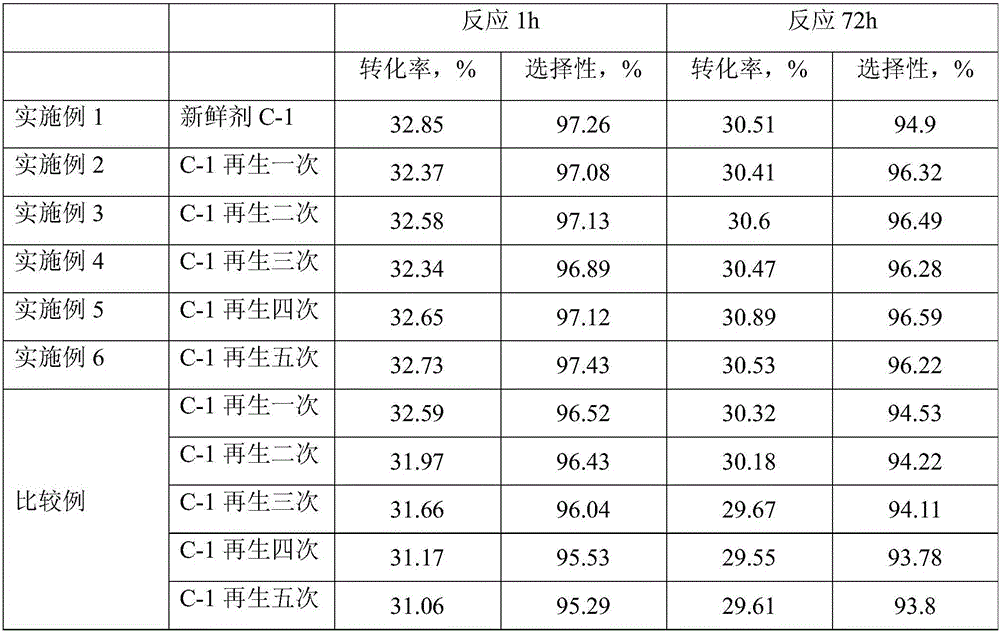Regeneration method of precious metal dehydrogenation catalyst
A technology for dehydrogenation catalysts and precious metals, applied in catalyst regeneration/reactivation, metal/metal oxide/metal hydroxide catalysts, chemical instruments and methods, etc., can solve alkali metal loss, metal aggregation, alumina carrier crystal Phase transition and other issues, to achieve the effect of easy operation, small temperature change, and prolong service life
- Summary
- Abstract
- Description
- Claims
- Application Information
AI Technical Summary
Problems solved by technology
Method used
Image
Examples
Embodiment 1
[0027] Weigh commercially available alumina carrier (γ phase, spherical, diameter 0.5mm, pore volume 0.71cm 3 / g, specific surface area 224m 2 / g) 30g, add deionized water dropwise to initial moistening, and the volume of consumed water is 27mL. Based on the weight content of 0.4% of the Sn element in the final catalyst, stannous chloride containing 0.12 g of Sn was weighed and dissolved in ethanol, and the volume was adjusted to 27 mL with ethanol. The prepared Sn-containing ethanol solution was added to 30 g of alumina carrier, mixed evenly, and aged at room temperature for 2 hours. Dry at 80°C for 8h, then bake at 600°C for 4h.
[0028] Based on the weight content of 0.5% of the Pt element in the final catalyst, weigh 0.18g of Pt-containing chloroplatinic acid and dissolve it in deionized water, set the volume to 27mL, add it to the Sn-containing alumina carrier, mix well, and age at room temperature for 4h. Dry at 100°C for 6h, and bake at 600°C for 4h. The sample obta...
Embodiment 2
[0031] After the C-1 fresh agent reacted for 72 hours, switch the raw material gas to pure hydrogen gas, purging for 1 hour, then the temperature dropped to 450°C, the pressure rose to 8MPa, and then hydrogen and tetralin were introduced at the same time. The speed is 1.5h -1 , the volume ratio of hydrogen to tetralin is 350:1, and the treatment time is 3h. After the treatment is over, switch to nitrogen, drop to normal pressure, and drop to room temperature, and the volumetric space velocity is 8.0h -1 The deactivated catalyst was cleaned by passing through cyclohexane for 2 hours, and then purged at 100° C. for 3 hours in a nitrogen atmosphere. Under a nitrogen atmosphere, raise the temperature of the deactivated catalyst to 400°C, and then pass a mixed gas of oxygen and nitrogen, the oxygen volume content in the mixed gas is 0.3%, and the volume space velocity is 1000h -1 , the processing time is 12h.
[0032] After the deactivated catalyst is treated with low-concentrat...
Embodiment 3
[0035] After C-1 primary regenerant reaction for 72 hours, the raw material gas is switched to pure hydrogen gas, purging for 1 hour, then the temperature drops to 400 ° C, the pressure rises to 10 MPa, and then hydrogen and tetralin are introduced at the same time. The air speed is 2.0h -1 , the volume ratio of hydrogen to tetralin is 200:1, and the treatment time is 2h. After the treatment is over, switch to nitrogen, drop to normal pressure, and drop to room temperature, the volumetric space velocity is 10.0h -1 Pass through cyclohexane to wash the deactivated catalyst for 1 h, and then purge at 80° C. for 4 h in a nitrogen atmosphere. Under a nitrogen atmosphere, raise the temperature of the deactivated catalyst to 350°C, and then pass a mixed gas of oxygen and nitrogen, the oxygen volume content in the mixed gas is 0.5%, and the volume space velocity is 500h -1 , the processing time is 8h.
[0036] After the deactivated catalyst is treated with low-concentration oxygen...
PUM
 Login to View More
Login to View More Abstract
Description
Claims
Application Information
 Login to View More
Login to View More - R&D
- Intellectual Property
- Life Sciences
- Materials
- Tech Scout
- Unparalleled Data Quality
- Higher Quality Content
- 60% Fewer Hallucinations
Browse by: Latest US Patents, China's latest patents, Technical Efficacy Thesaurus, Application Domain, Technology Topic, Popular Technical Reports.
© 2025 PatSnap. All rights reserved.Legal|Privacy policy|Modern Slavery Act Transparency Statement|Sitemap|About US| Contact US: help@patsnap.com

